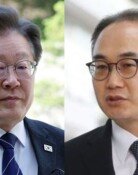Japans Success in Rocket and Space Technology
Japans Success in Rocket and Space Technology
Posted July. 14, 2008 08:11,
The Dong-A Ilbo visited Mitsubishi Heavy Industries, an undisputed leader in rocket manufacturing and launching among Japanese companies, to get a close look at the gap between Korea and Japan in space technology.
○ Korea vs. Japan
The assembly line of rocket fuselage at the companys Tobishima factory in Aichi Prefecture in Nagoya was rolling out H-2A rockets that measure over 52 meters. H-2A rocket is the fifth model Japan created after 1975 when it successfully developed and launched its very first model, N-1, with the help of the United States.
Although H-2A more or less resembles Koreas KSLV-1 in its ability to put an artificial satellite in orbit, there is a huge difference in terms of performance and technology.
First, while KSLV-1 is scheduled to fly off with the second science and technology satellite weighing 100 kilograms, H-2A can load up to 6 tons by installing four large complementary rockets.
Another significant difference lies in fuel: KSLV-1 runs on kerosene while H-2A on liquefied hydrogen.
Toshihiko Nakagawa, who is responsible for the development of H-2A, said, Although Japan once used kerosene for its rockets, it is no longer in use since its fuel efficiency is far below that of liquefied hydrogen. He added, It is difficult to handle liquefied gas because it is highly sensitive and unstable. Therefore, the critical part of our rocket technology is to control and handle this fuel.
The largest difference between the nations rocket technologies lies in whether it is completely home-grown. While the localization level of KSLV-1 only stands at the 60-percent range, H-2A relies almost entirely on Japanese technology.
Nakagawa said, We import some components but it is purely for cutting down costs. We already achieved 100-percent localization with H-2 rockets before this one.
○ Japans next goal: commercialization
The next goal of Japan, which already achieved 100-percent localization 14 years ago, is commercialization.
In the past, Mitsubishi Heavy Industries was only assigned to produce rockets after taking orders from the Japan Aerospace Exploration Agency (JAXA). However, it also took over the launching service arm of the agency last year. Its debut project was the 13th H-2A rocket that carried Japans lunar explorer Kaguya last September.
With that as the start, the company is looking for business opportunities overseas, and its very first target is Korea, which is at its infant stage in terms of rocket launching.
Shoichiro Asada of Mitsubishi Heavy Industries aerospace business headquarters said, At the moment, we have made a bid for the launching service provider of the launch of Koreas multipurpose satellite Arirang 3 scheduled to launch in 2011. It has been reported that the companys offer only costs 50-70 percent of what its rival Russia suggested.
Mitsubishi told the newspaper, We succeeded in launching H-2A rockets for seven consecutive times since the launch of the seventh rocket in 2005. Although we failed with the sixth rocket, the overall launching success rate is 92.3 percent. It added, Our H2-As credibility abroad is also testified by the fact that the insurance rate against a failed launch is equivalent to that of leading U.S. and European companies.
iam@donga.com







